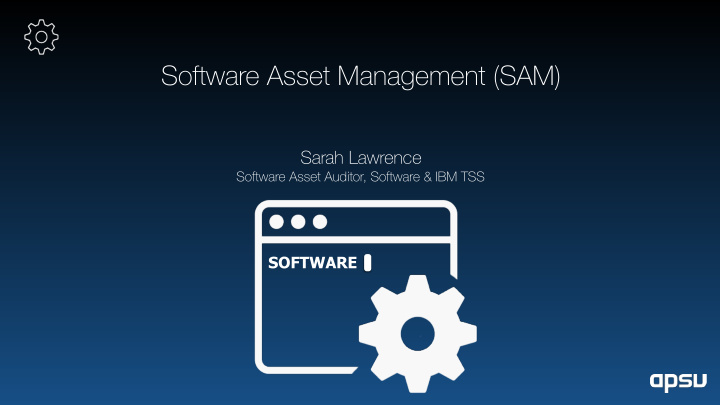



Software Asset Management (SAM) Sarah Lawrence Software Asset Auditor, Software & IBM TSS SOFTWARE
What is Software Asset Management? Software Asset Management (SAM) is a business practice that involves managing and optimising the purchase, deployment, maintenance, utilisation, and disposal of software applications within an organisation. It follows the lifecycle of the software and enables an organisation to capitalise on that asset. Plan Acquire Align IT to Negotiate agreements corporate strategy to maximise value Retire Provide for orderly Deploy disposition of assets; Processes to ensure disposed, auctioned, standardised, committed donated Return On Investment and employee purchase Manage Implement Support Infrastructure and process to enhance productivity and satisfaction
High Level SAM Plan Policies & SAM Inventory Organisation Procedures Optimisation Maintain your SAM plan using Establish the software Inventory all licenses and What do you have already? the following: lifecycle in order to manage it proof of purchase effectively Where is it allocated? Spot checks Record and organise license Acquisition, retirement, evidence Is it still in regular use? Inventory reports storage, disaster recovery all need a process Do they match the versions Discovery tools or manual? Quarterly audits you’re using now? Create a SAM culture Working with other throughout your organisation departments
Ensuring Audit Readiness Around 40% of mid-size and large businesses can expect an external audit A software audit can tie up valuable IT resources for up to a year if you don’t have an organised system of monitoring Gartner: Most organisations are over-licensed for 60% of its software and under-licensed for 30%
Benefits of Managed Service Continuous management of software estate Early identification of risks/exposures Highlight cost savings/avoidance Deeper understanding of the customer and their requirements Reduces risk of audit penalties
Server Virtualisation Server virtualisation can dramatically increase the probability of software license non-compliance, for several reasons: • The ease of duplicating operating systems and applications on virtual machines • Virtual machine mobility - moving them from one physical host to another • The complexity of software license terms for virtual environments
Server virtualisation rules include: Device-specific software license models: These tie the software license to a particular computer and may also impose move restrictions. With this kind of license, the dynamic load balancing that is sometimes applied in VMware environments can cause non-compliance Processor-based software license models: These software licenses require details of the physical processor(s) in order to determine license compliance, but on a virtual machine the hardware details are often hidden by the hypervisor Virtual machines per host software license rules: These allow the software to run on a certain number of virtual machines for each physical machine with a valid license
APSU Engagement APSU can facilitate the management of License Compliance in 3 ways: • Business as usual – providing engagement is made prior to any audit notification, APSU will charge 10% of any savings • Audit Notification – APSU will work to provide housekeeping on licenses, charge of 15% of any savings that are made • In Compliance – APSU engaged after the penalty notice is issued, we charge 20% of any reduction in penalty.
Recommend
More recommend